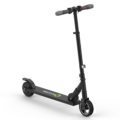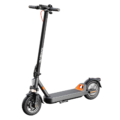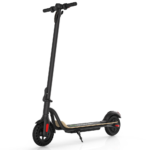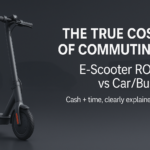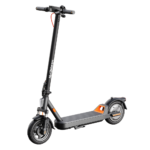- Home
- Scooters
- Electric Scooters
- MEGAWHEELS A5
MEGAWHEELS A5
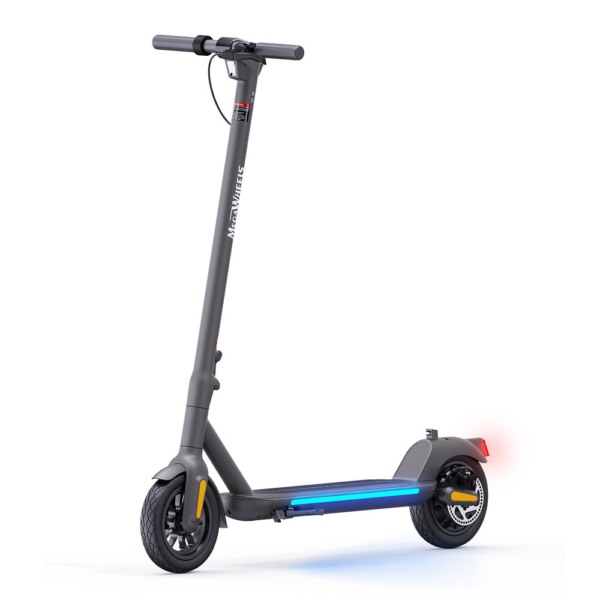

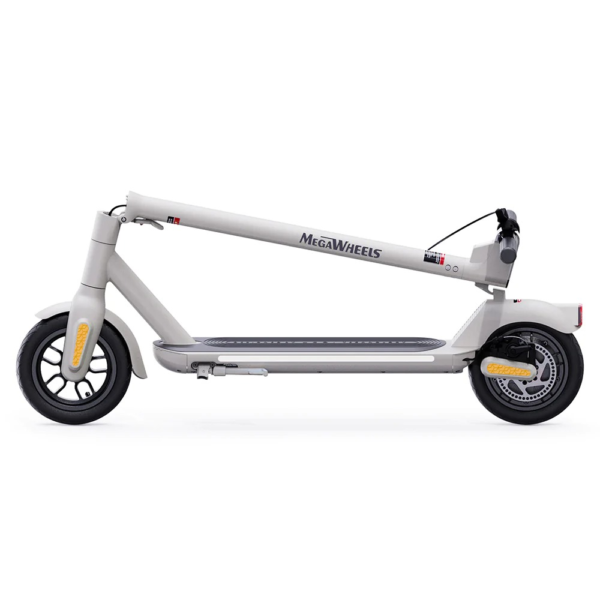
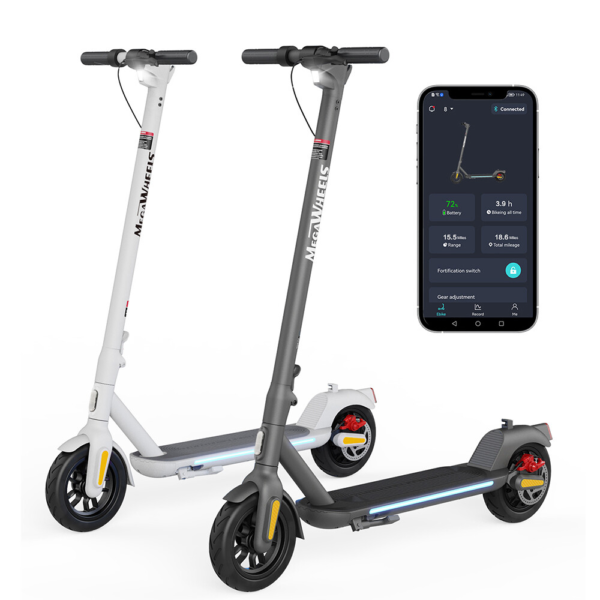
- Battery Range: 18.6 miles (30 km)
- Top Speed: 15.5 mph (25 km/h)
- Motor Power: 350 W
- Weight Capacity: 265 lb (120 kg)
- Charging Time: ~4 h
- Scooter Weight: 30.8 lb (14.0 kg)
PROS
- Disc + electronic braking
- 9″ pneumatic tires
- IPX5 rating
- Reasonable 30.8 lb weight
- App support
- 265 lb load capacity
CONS
- 15.5 mph top speed
- ~18.6-mile range
- No suspension listed
- Folded size not provided
Table of contents
- What Is the MEGAWHEELS A5?
- How the MEGAWHEELS A5 Works
- Key Specifications
- Design & Build Quality
- Performance Fundamentals
- Battery, Range & Efficiency
- Ride Quality & Comfort
- Braking & Safety Features
- Portability & Daily Usability
- Maintenance & Care
- Weather & Seasonal Considerations
- MEGAWHEELS A5 vs Alternatives
- Who the MEGAWHEELS A5 Is (and Isn’t) For
- FAQs
- Glossary
- Final Thoughts
The MEGAWHEELS A5 is a compact, app-enabled commuter scooter designed for simple daily travel and short urban hops. It balances low weight, straightforward controls, and dependable range with a sturdy fold and puncture-proof tires. Because its performance is tuned for city speeds and mixed riders, the A5 suits students, new e-scooter owners, and multi-modal commuters who want a light, no-drama ride without fussy upkeep.
What Is the MEGAWHEELS A5?
At its core, the MEGAWHEELS A5 is a 36 V, rear-wheel-drive electric scooter with a 350 W brushless hub motor, a 7.8 Ah lithium-ion battery (about 281 Wh), and 9-inch puncture-proof tubeless (airless/honeycomb) tires. The top speed is rated around 25 km/h (15.5 mph), and the claimed range is up to 30 km (18.6 mi) in ideal conditions. It carries up to 120 kg (265 lb) yet keeps the net weight around 14 kg (30.9 lb), so most riders can lift it into a trunk or up a flight of stairs.
Just as important, the A5 layers in small quality-of-life touches that add up: a clear cockpit display, front and rear lighting, a kick-to-start safety, and Bluetooth connectivity through the LEQISMART app. Altogether, these details make the A5 feel friendly from day one while still giving you control over ride modes and cruise control.
How the MEGAWHEELS A5 Works
Although an e-scooter looks simple, a few components do the heavy lifting. Understanding them helps you ride smoothly and keep the scooter in good shape.
Motor & Controller. The A5 uses a rear brushless hub motor rated at 350 W. Think of the controller as the “brain” that meters power to the motor. When you press the thumb throttle, the controller decides how much current to send based on your chosen speed mode, battery state, and safety limits. Rear-wheel drive improves traction during acceleration because your weight naturally shifts rearward.
Battery & BMS. The 36 V pack at 7.8 Ah stores about 281 Wh of energy (36 V × 7.8 Ah). A built-in Battery Management System (BMS) protects the pack from over-charge, over-discharge, over-current, short circuit, and high temperature. Consequently, the battery delivers repeatable performance while guarding against misuse.
Throttle & Speed Modes. The right-side thumb throttle commands the controller. Three speed levels help fine-tune behavior: a low mode for crowded paths, a middle mode for relaxed cruising, and a full mode that reaches the rated top speed. In addition, a kick-to-start sequence (about 4 km/h / 2.5 mph nudge) avoids sudden take-offs from a dead stop.
Brakes & Regen. Braking combines a rear mechanical disc (lever-actuated) with electronic motor braking. The electronic part adds smooth initial deceleration and can feed a trickle of energy back to the battery. The disc brake then supplies firm bite to finish the stop.
Because each piece is modest but well matched, the A5 feels predictable. It won’t surprise you with abrupt surges or harsh stops when used in the default modes.
Key Specifications
Below is a clean, consolidated table of the official core details, converted into both metric and US units where helpful.
| Category | Item | Details |
|---|---|---|
| General | Model | MEGAWHEELS A5 |
| Rider Load | Max 120 kg (265 lb) | |
| Net Weight | Approx. 14 kg (30.9 lb) | |
| Water/Dust Protection | IPX5 | |
| App | LEQISMART (Bluetooth) | |
| Performance & Power | Motor | Rear brushless hub, 350 W |
| Top Speed | ~25 km/h (15.5 mph) | |
| Speed Levels | 3 modes (low/medium/high) | |
| Gradeability | ~15% climbs (short hills) | |
| Battery, Charging & Electrical | Battery | 36 V, 7.8 Ah (≈ 281 Wh) |
| Claimed Range | Up to 30 km (18.6 mi) | |
| Charging Time | ~4 hours (100–240 V AC input) | |
| BMS Protection | Over-charge/-discharge/-current, short-circuit, over-temp | |
| Build & Dimensions | Tires | 9-inch puncture-proof tubeless (airless/honeycomb) |
| Frame | Aluminum alloy chassis; folding stem | |
| Deck | Rubberized standing surface | |
| Unfolded Size | 112.4 × 44 × 121.5 cm (44.3 × 17.3 × 47.8 in) | |
| Folded Size | 112.4 × 44 × 46.9 cm (44.3 × 17.3 × 18.5 in) | |
| Safety & Control | Brakes | Rear mechanical disc + electronic (regen) |
| Lights | LED headlight, brake/tail light; side accent lighting | |
| Start Logic | Kick-to-start (≈ 4 km/h / 2.5 mph) | |
| Features & Extras | Display | Clear cockpit screen for speed/battery/mode |
| App Functions | Ride stats, mode settings; cruise control | |
| Cruise Control | Yes (app-configurable) | |
| Warranty & Compliance | Limited Warranty | Coverage varies by region/seller |
| Compliance Notes | IPX5 ingress protection; radio module registered; model ID labeling on chassis |
Note: Dimensions and weights are manufacturer-reported. Real-world range varies with rider weight, terrain, temperature, and speed.
Design & Build Quality
Frame and Fold
The A5 uses an aluminum alloy frame with a locking, one-step folding handle near the base of the stem. Because the hinge is low and the latch has a secondary catch, the fold feels positive rather than flimsy. After folding, the hook secures the stem to the deck area, making it easier to lift with one hand. The folded length stays the same as the deck (112.4 cm / 44.3 in), while the folded height drops to about 46.9 cm (18.5 in), which allows horizontal storage on a shelf or in a trunk.
Deck and Cockpit
The standing deck is rubberized and long enough to allow a natural staggered stance. The cockpit is deliberately restrained: a central display shows speed, battery bars, and mode; the right thumb throttle is easy to modulate; and the left lever pulls the rear disc while also triggering electronic braking. Because the controls are simple, riders swap from a kick scooter to the A5 with almost no learning curve.
Fit and Finish
Panel gaps are tight, and the cable routing is tidy along the stem. The wheel covers, lighting modules, and latch hardware feel consistent for this class. You also get uniform fasteners, which makes periodic bolt checks far simpler. Finally, the airless tires avoid messy valve access and flats; that choice reduces upkeep even if it trades a bit of plushness.
As a result, the A5’s build specifications align with its goal: a lean commuter that favors robust parts over complicated extras.
Performance Fundamentals
Acceleration Feel
In high mode, the A5 spools up in a measured way. It isn’t jumpy off the line because the controller smooths the current ramp. Therefore, low-speed maneuvers remain calm even in busy areas. From 0 to cruising speed, you’ll feel steady pull with no drama from the rear wheel. New riders, especially, appreciate this gentler learning curve.
Cruising Stability
At 20–25 km/h (12–15.5 mph), the chassis tracks straight, and the stem shows minimal flex for this category. The honeycomb tires add small-bump damping yet keep a direct road feel. On clean pavement the scooter holds its line with little effort. If the path gets wavy, shift your weight slightly rearward and keep arms loose; the A5 responds best when you avoid death-gripping the bar.
Hill-Climb Behavior (7–10% Grades)
On short 7–8% rises, the A5 maintains momentum if you enter with some speed. As grades approach 10%, it will slow but continue if the rider is in the lighter-to-average range and the battery is well charged. For heavier riders or long hills, plan to carry a bit more entry speed, and consider using medium mode on the approach to conserve energy, then switch to high mode as you hit the incline. Because the motor is rear mounted, traction remains predictable.
Battery, Range & Efficiency
Rated vs. Real-World Range
The pack stores roughly 281 Wh. On flat ground with a middle-weight rider and conservative speeds, the up-to-30 km (18.6 mi) claim is reachable. However, real life brings headwinds, hills, frequent stops, and colder days. Consequently, expect closer to 18–25 km (11–16 mi) for a mixed urban loop at moderate speed. If you ride fast or climb often, the figure will drop further. On the flip side, smooth paths at 15–18 km/h (9–11 mph) stretch range nicely.
What Most Affects Range
- Rider Mass. Heavier riders consume more energy at a given speed.
- Speed & Starts. Aerodynamic drag rises with speed; frequent stop-and-go also hurts efficiency.
- Temperature. Cold batteries deliver less energy; very hot conditions trigger protective limits.
- Terrain & Surface. Hills and coarse asphalt both add drag.
Charging Practices
Charging from low to full typically takes around four hours. Because lithium-ion prefers partial states of charge, you’ll extend lifespan if you store the A5 around 50–70% when unused for weeks. Additionally, avoid leaving it plugged in for days. Finally, keep the charge port cap sealed during rides and store the scooter in a cool, dry place.
Ride Quality & Comfort
Tires and Feel
The 9-inch puncture-proof tubeless tires rely on honeycomb structures rather than air. As a result, they shrug off nails and glass, and you never need a pump. They also hold their shape under cornering loads, which yields precise steering. However, airless tires transmit more texture than pneumatics. Therefore, bend your knees on rough patches and reduce speed on broken pavement to keep things supple.
Suspension Behavior
The A5 does not use a traditional fork or rear shock. Instead, comfort comes from the tire design, the long deck, and your stance. With a relaxed, slightly bent posture, you’ll absorb seams without chatter. Over expansion joints, the front remains composed, and the rear tracks cleanly. Larger potholes should be avoided; as always, choose smoother lines.
Ergonomics and Stem Flex
The bar height and width fit most riders from about 130–200 cm (4 ft 3 in to 6 ft 7 in) tall. Because the stem is stout for its weight class, flex stays within a comfortable range at city speeds. If you sense wobble at top speed on choppy surfaces, shift a little weight rearward and lower your torso; that simple adjustment calms the steering.
Braking & Safety Features
Brake System
The rear mechanical disc provides the main stopping power, while electronic motor braking adds controlled initial deceleration. Squeeze the lever lightly to engage smooth electronic drag; squeeze deeper to feel the disc bite. Because the tire compound is firm, the rear remains predictable even in big stops. Practice a few progressive, straight-line stops in an empty lot to learn the lever travel and e-brake blend.
Lights, Reflectors & Visibility
A bright LED headlight helps you see and be seen at dusk. The tail light brightens on braking, and side accent lighting increases lateral visibility. Even so, augment your visibility with reflective clothing in dark conditions. Moreover, ride at a speed that matches your headlight’s throw; don’t outrun your beam.
IP Rating & Wet Riding
The A5 is rated IPX5 for splashes and light sprays from any direction. That rating offers extra resilience during unavoidable damp patches. Nevertheless, slippery surfaces and reduced visibility make wet riding risky. Therefore, slow down if you’re caught in drizzle, avoid puddles that may hide potholes, and dry the scooter after use.
Portability & Daily Usability
Carrying and Storage
At about 14 kg (30.9 lb), the A5 is manageable for most adults. The folded package—roughly 112.4 × 44 × 46.9 cm (44.3 × 17.3 × 18.5 in)—slides into small trunks and tight apartment spaces. Because the latch is quick and the hook secure, you can fold at the station platform, then carry the A5 onto a train without wrestling with it.
Folding Habit Tips
Always confirm the latch’s secondary catch has snapped into place both when folding and unfolding. Additionally, check that cables aren’t pinched. If you store it vertically, ensure the front wheel sits against a wall to prevent roll-away.
Everyday Security
A discrete frame lock point near the rear helps integrate a compact lock. Since e-scooters are easy to lift, secure the A5 to a rack rather than just locking the wheel. When leaving it for longer periods, bring it indoors.
Maintenance & Care
Despite the A5’s low-maintenance design, small habits keep it running smoothly.
Before Each Ride (30 seconds).
- Glance at the tires for embedded debris.
- Squeeze the brake lever to confirm firm feel.
- Check that the latch is fully closed.
- Confirm battery bars and speed mode.
Weekly (5 minutes).
- Inspect stem bolts, brake caliper bolts, and axle nuts for snugness.
- Wipe the deck and lights clean.
- Listen for rubbing sounds from the rear disc and adjust if needed.
Monthly (15 minutes).
- Check brake pad wear and caliper alignment.
- Clean the charge port area and reseat the rubber cap.
- Review the app for firmware notices and recalibrate the cruise control speed if you’ve changed tires or load.
Seasonal (30–45 minutes).
- Do a deeper fastener audit (hinge, clamp, and handlebar screws).
- Clean the underside and wheels.
- Inspect the rear rotor for glazing; scuff lightly with fine emery paper if braking feels squealy.
- For long storage, charge to ~60% and top off monthly.
Because the A5 uses airless tires, you never manage pressure. That alone reduces service time compared with pneumatic setups.
Weather & Seasonal Considerations
Rain
While IPX5 helps with splashes, painted lines, metal plates, and wet leaves reduce grip dramatically. Therefore, cut speed, brake earlier, and keep your body relaxed to maintain traction. Avoid puddles; hidden holes can bend rims or unseat you.
Heat
High heat increases battery and controller temps. If the deck feels very warm after a long climb, let the scooter rest in the shade for a few minutes before charging. Additionally, don’t leave the A5 in a closed car under direct sun; heat shortens battery life.
Cold
Below ~10 °C (50 °F), range falls as cell chemistry slows. Plan shorter trips, and finish with a little charge reserve to avoid deep discharge. Store the scooter indoors when possible.
MEGAWHEELS A5 vs Alternatives
When should you pick the A5 rather than a different class?
If you’d like a sibling model with a slightly different tuning, consider the MEGAWHEELS C2 for similar city rides and everyday errands.
Compared to ultra-budget models. The A5’s 350 W motor, stronger deck, and airless 9-inch tires deliver more reliable acceleration and fewer flats. It also adds an app and cruise control many bare-bones scooters skip.
Compared to commuter class with 10-inch pneumatics. Heavier commuters with air tires ride softer and often go farther per charge. However, they weigh more and require tire pressure checks and puncture repair. The A5 strikes back with lower weight and zero-flat maintenance.
Compared to performance scooters. High-output models climb faster and hit higher speeds, but they are heavy, expensive, and overkill for short urban hops. The A5 is easier to carry, store, and charge, and it stays within typical city speed policies.
Compared to off-road or dual-motor scooters. Those scooters use knobby tires and suspension for trails. The A5, by contrast, is a paved-path specialist. Choose it if your routes are primarily bike lanes, campus paths, and sidewalks where allowed.
In short, pick the A5 when you value portability, simplicity, and predictable urban performance over raw speed and long-distance touring.
Who the MEGAWHEELS A5 Is (and Isn’t) For
Great For
- Students and campus riders. Because it’s compact, it tucks under desks and in dorm closets.
- First-time e-scooter owners. The kick-to-start and gentle throttle ramp inspire confidence.
- Multi-modal commuters. The quick fold and modest weight work well with buses and trains.
- Short-range urban errands. The battery handles grocery and café trips with miles to spare.
Maybe Not For
- Long suburban commutes. Daily 20+ km (12+ mi) each way is a stretch without mid-day charging.
- Hilly districts with long climbs. It will crest short 7–10% hills, yet it’s not a mountain goat.
- Trail or gravel riders. Airless tires and no suspension don’t suit rough track adventures.
FAQs
1) How fast does the A5 go, and can I change the limit?
The rated top speed is about 25 km/h (15.5 mph). You can choose among three speed modes to tailor acceleration and top speed for conditions.
2) What’s the real-world range?
Expect around 18–25 km (11–16 mi) for mixed city riding with a mid-weight rider, moderate speeds, and mild weather. Higher speeds, hills, or cold lower range.
3) Does it have cruise control?
Yes. After holding a steady speed for several seconds, cruise can engage; you can also configure it through the app. Always be ready to brake to disengage.
4) Are the tires solid or pneumatic?
They’re 9-inch puncture-proof tubeless (airless/honeycomb). You won’t need to check pressure or patch flats, though ride feel is firmer than air-filled tires.
5) Can I ride in the rain?
The A5 carries an IPX5 rating for splashes. Nevertheless, ride carefully on wet surfaces, avoid puddles, and dry the scooter after use.
6) What is the folded size for storage?
Approximately 112.4 × 44 × 46.9 cm (44.3 × 17.3 × 18.5 in). It fits in most car trunks and small apartment spaces.
7) Where can I find a MEGAWHEELS A5 overview?
You’re reading one—this is a detailed MEGAWHEELS A5 overview that covers design, performance, care, and suitability for different riders.
Glossary
- Ah (Amp-hour): Battery capacity. Higher Ah means more stored charge.
- Wh (Watt-hour): Battery energy (V × Ah). It predicts potential range.
- Brushless Hub Motor: Electric motor built into the wheel; low maintenance.
- Controller: The electronic unit that meters power to the motor.
- Kick-to-Start: Safety feature requiring a small manual push before throttle.
- Regen (Regenerative Braking): Motor braking that recovers a little energy.
- BMS (Battery Management System): Circuitry protecting and balancing the pack.
- IP Rating: Ingress protection against water/dust; IPX5 resists low-pressure sprays.
- Stem Flex: Small, normal handlebar movement from load and hinge flex.
- Gradeability: Steepness the scooter can climb (in percent).
- Tubeless Honeycomb Tire: Airless tire with cavities for compliance and puncture resistance.
- Cruise Control: Electronic system that holds a set speed until you brake or adjust.
- Rear-Wheel Drive: Motor drives the rear wheel; helps traction during acceleration.
- Electronic Brake: Motor-based braking that slows the wheel electrically.
- Deck: The standing platform; usually rubberized for grip.
Final Thoughts
The MEGAWHEELS A5 focuses on the fundamentals: sensible speed, portable weight, reliable range, and maintenance-light tires. It’s not built for high-speed blasts or rough backroads. Instead, it nails the everyday commute, the last mile to the metro, and the quick run to class. Because it folds fast, charges quickly, and feels predictable, it fades into your routine—exactly what a city scooter should do.
If your priorities are ease, simplicity, and low upkeep, the A5 lands in the sweet spot. Keep the battery comfortably charged, ride within its city-speed envelope, and perform quick monthly checks. In return, it will carry you through your week with minimal fuss.
Specifications
General
| Model The Model specifies the exact version or name of the scooter. It helps identify its unique design, features, and specifications within the manufacturer’s product line. Knowing the model makes it easier to compare options, find compatible accessories, or look up support information. | A5 |
| Brand The Brand identifies the manufacturer or company that designs and produces the scooter. A trusted brand is a sign of quality, reliability, and good customer support. Well-known brands often have higher standards for safety, performance, and after-sales service, giving you more confidence in your purchase. | MEGAWHEELS |
| Release Date The Release Date indicates when the scooter model was officially launched on the market. This helps you know how current the design, technology, and features are. A newer release date often means updated components, improved performance, and the latest safety or smart features. | 17 November 2025 |
| Recommended Age Recommended Age indicates the minimum age range that the scooter is designed for, based on safety, size, and ease of use. Following the recommended age helps ensure that riders can handle the scooter’s speed, weight, and controls comfortably and safely. Always check local laws and use protective gear, especially for younger riders. | +10 |
Performance & Power
| Motor Power (Wattage) What it means: The motor power, measured in watts (W), shows how strong the scooter’s electric motor is. Why it matters: Higher wattage usually means better acceleration, more torque, and improved performance on hills or rough terrain. For example, a 250W motor is good for flat city roads and light riders, while a 500W or 1000W motor provides more power for faster speeds or climbing steep inclines. | 350 W hub motor |
| Top Speed The Top Speed indicates the maximum speed that the scooter can reach under optimal conditions. It’s usually measured on level ground with a fully charged battery and an average rider weight. A higher top speed allows you to travel longer distances faster, but always ensure you ride within legal speed limits and your personal comfort zone for safety. | 15.5 mph (25 km/h) |
| Battery Capacity Battery Capacity refers to the total amount of energy the scooter’s battery can store, usually measured in ampere-hours (Ah) or watt-hours (Wh). A higher battery capacity means you can ride longer distances on a single charge, reducing the need for frequent recharging. Keep in mind that actual range can vary depending on rider weight, terrain, speed, and weather conditions. | 36 V 7.8 Ah (281 Wh) |
| Estimated Range per Charge The Estimated Range per Charge indicates the average distance the scooter can travel on a single full battery charge. This range is calculated under optimal conditions, such as flat terrain, moderate speed, and average rider weight. Real-world range may vary depending on riding style, terrain, weather, and load. A longer range means fewer recharges and greater freedom for longer trips. | 18.6 miles (30 km) |
| Hill Climb Ability Hill Climb Ability describes the maximum incline or slope that the scooter can handle while maintaining stable performance. It’s typically expressed as a percentage or in degrees. A higher hill climb rating means the scooter can tackle steeper hills without losing too much speed or power. Actual climbing performance may vary based on rider weight, battery charge, and terrain conditions. | 15% grade |
| Drive System The Drive System refers to how power from the motor is delivered to the wheels. Electric scooters typically use either a hub motor (directly integrated into the wheel) or a chain/belt drive system. A high-quality drive system ensures smooth acceleration, efficient power transfer, and low maintenance. The choice of drive system affects performance, noise level, and overall ride experience. | Not specified |
Charging & Electrical
| Charging Time Charging Time indicates how long it takes to fully recharge the scooter’s battery from empty to 100% using the standard charger provided. Faster charging means less downtime and more time on the road. Actual charging time may vary slightly depending on battery capacity, charger output, and environmental conditions. | About 4 hours |
| Battery Type Battery Type refers to the specific technology used in the scooter’s battery, which affects performance, lifespan, weight, and charging time. Most modern electric scooters use high-quality lithium-ion (Li-ion) batteries because they offer a good balance of energy density, durability, and low maintenance. A reliable battery type ensures consistent power delivery and longer riding ranges. | Lithium-ion pack (Smart BMS not specified) |
| Removable Battery A Removable Battery means the battery pack can be easily detached from the scooter for convenient charging and replacement. This feature allows you to charge the battery separately, swap it with a spare for extended range, or securely store it indoors in extreme weather. Removable batteries add flexibility and make it easier to keep your scooter powered up wherever you are. | Non-removable internal battery (fixed pack) |
| Regenerative Braking Regenerative Braking is an energy-saving feature that converts some of the energy normally lost during braking back into battery power. When you slow down or brake, the motor works in reverse to generate electricity, which helps extend the scooter’s range and improves overall efficiency. This system also reduces wear on traditional brake components, leading to lower maintenance over time. | Not specified |
| Lighting Lighting refers to the built-in front and rear lights that enhance visibility and safety when riding in low-light conditions or at night. Good lighting helps you see the road ahead and ensures that other road users can see you. Many scooters include LED headlights, taillights, and sometimes brake lights or side reflectors for added safety and compliance with local traffic regulations. | LED headlight, taillight, side lights |
Build & Dimensions
| Scooter Weight Scooter Weight refers to the total weight of the scooter when fully assembled, including the battery. This affects how easy it is to carry, lift, and store the scooter when not in use. A lighter scooter is more portable and convenient for commuting, especially if you need to carry it upstairs or onto public transport. Keep in mind that a sturdy frame and quality components may add to the weight but also contribute to better durability and ride stability. | 30.8 lb (14.0 kg) |
| Maximum Rider Weight Maximum Rider Weight indicates the highest rider weight that the scooter is designed to safely support while maintaining optimal performance and stability. Staying within this limit helps ensure reliable acceleration, braking, and climbing ability, and it protects the frame, suspension, and motor from excessive strain. Exceeding the recommended limit may reduce performance and increase wear on components. | 265 lb (120 kg) |
| Deck Size Deck Size refers to the dimensions of the scooter’s standing platform. A wider and longer deck provides more foot space, allowing you to stand comfortably and adjust your stance while riding. A well-sized deck improves balance and stability, especially on longer rides or at higher speeds. Compact decks, on the other hand, help keep the scooter lightweight and portable. | Aluminum frame; commuter deck |
| Handlebar Height Handlebar Height refers to the distance from the deck to the handlebars, which affects your riding posture and comfort. An appropriate handlebar height helps you maintain good balance, reduces strain on your back and arms, and makes steering more comfortable. Some scooters have adjustable handlebars to fit riders of different heights, while others have a fixed height for a streamlined design. | Not specified |
| Folding Mechanism The Folding Mechanism describes how easily and securely the scooter can be folded for carrying and storage. A well-designed folding system lets you quickly collapse the scooter into a compact size, making it convenient to transport on public transit, store under a desk, or fit into a car trunk. Look for sturdy latches and safety locks to ensure the scooter stays firmly in place when folded or unfolded. | Foldable (mechanism not specified) |
| Dimensions Folded Dimensions indicate the size of the scooter when it’s fully folded. This measurement shows how much space the scooter will take up when stored or carried, making it easier to check if it will fit in your car trunk, under a desk, or in a closet. Compact folded dimensions are ideal for commuters who need to bring their scooter on public transport or store it in tight spaces. | Unfolded: 44.3 × 17.3 × 47.8 in; Folded: Not specified |
| Material Material refers to the primary construction materials used for the scooter’s frame and key components. High-quality materials like aircraft-grade aluminum, reinforced steel, or durable composites provide strength, stability, and a lighter overall weight. A sturdy material ensures the scooter can handle daily wear and tear while maintaining safety and performance. | Aluminum alloy |
Safety & Control
| Brake Type(s) Brake Type(s) describe the braking systems the scooter uses to help you slow down or stop safely. Common brake types include mechanical brakes (like drum or disc brakes), electronic brakes, and foot brakes. Many scooters combine multiple braking systems for added safety and shorter stopping distances. The type and quality of brakes affect your control, especially when riding at higher speeds or on slopes. | Rear disc + electronic brake |
| Suspension Suspension refers to the system that absorbs shocks and vibrations while riding, providing a smoother and more comfortable ride over uneven or rough surfaces. Scooters may have front suspension, rear suspension, or dual suspension for better shock absorption and stability. Good suspension helps reduce rider fatigue and improves control, especially when riding on bumpy roads or off-road paths. | None stated |
| Tire Type Tire Type refers to the kind of tires the scooter uses, which directly affects ride comfort, traction, and maintenance. Common types include solid (airless) tires, pneumatic (air-filled) tires, or hybrid options. Pneumatic tires offer better shock absorption and a smoother ride on rough surfaces, while solid tires are puncture-proof and require less upkeep. The right tire type helps ensure safe handling and a comfortable ride in different conditions. | 9″ pneumatic |
| Tire Size Tire Size indicates the diameter and width of the scooter’s tires, which affect ride comfort, stability, and how well the scooter handles different terrains. Larger tires generally offer better shock absorption and a smoother ride over bumps and rough surfaces, while smaller tires keep the scooter lighter and more portable. Choosing the right tire size helps ensure a balance between agility and comfort. | 9-inch |
| Kickstand The Kickstand is a built-in stand that allows you to park your scooter upright when it’s not in use. A sturdy kickstand keeps the scooter stable and prevents it from tipping over, protecting it from scratches and damage. It also makes storing and accessing your scooter more convenient, whether you’re at home, work, or on the go. | Not specified |
| Water Resistance Rating Water Resistance Rating indicates how well the scooter is protected against water and moisture, usually shown as an IP (Ingress Protection) rating. This rating helps you understand whether the scooter can handle light rain, splashes, or wet roads without damage. While most scooters are not fully waterproof, a good water resistance rating adds peace of mind when riding in changing weather conditions. Always avoid deep puddles or submerging the scooter to protect its electrical components. | IPX5 |
Features & Extras
| Display/Console The Display (or Console) shows important real-time information about your ride, helping you monitor your scooter’s status at a glance. Typical displays show speed, battery level, distance traveled, and riding mode. Some models also include additional features like Bluetooth connectivity, app integration, or backlighting for better visibility at night. A clear and easy-to-read display enhances safety and convenience on every trip. | LCD display (speed/battery) |
| Ride Modes Ride Modes refer to the different speed and power settings you can choose to match your riding style or road conditions. Common modes include eco for maximum range and energy efficiency, standard for everyday balance, and sport or turbo for higher speed and stronger acceleration. Switching between ride modes allows you to customize performance, conserve battery, and ride safely in various environments. | 3 speed modes (6/15/25 km/h) |
| Smart App Connectivity Smart App Connectivity lets you pair your scooter with a dedicated mobile app via Bluetooth. Using the app, you can monitor real-time ride stats like speed, battery level, and range, adjust settings such as ride modes or cruise control, lock the scooter for added security, and sometimes receive firmware updates. This feature adds convenience and allows you to personalize your riding experience right from your smartphone. | Bluetooth app (brand app) |
| Anti-Theft System The Anti-Theft System helps protect your scooter from unauthorized use or theft. This feature can include built-in alarms, electronic motor locks, GPS tracking, or remote locking through a mobile app. A good anti-theft system provides peace of mind when parking your scooter in public spaces, adding an extra layer of security to safeguard your investment. | Not specified |
| Cruise Control Cruise Control allows you to maintain a steady speed without continuously holding the throttle. This feature makes longer rides more comfortable by reducing hand fatigue and providing a smoother, more relaxed riding experience — especially on flat, open roads or bike lanes. For safety, cruise control can usually be easily activated or deactivated while riding. | Not specified |
| Accessories Included Accessories Included lists the additional items that come with the scooter to enhance your riding experience and convenience. Common accessories may include a charger, kickstand, bell, lights, phone holder, or carrying strap. These extras add value by making your scooter safer, easier to use, and ready to ride straight out of the box. | Scooter, charger, user manual, tool set |
Warranty & Compliance
| Warranty Period The Warranty Period indicates how long the manufacturer guarantees the scooter against defects in materials and workmanship under normal use. A good warranty provides peace of mind, showing the brand’s confidence in its product quality. Always check what parts are covered, such as the frame, battery, and motor, and follow the maintenance guidelines to keep your warranty valid. | 12 months (region-dependent) |
| Certifications Certifications confirm that the scooter meets specific safety, quality, and environmental standards set by recognized organizations or regulatory bodies. Common certifications may include CE, RoHS, UL, or other local compliance marks, depending on your region. These certifications ensure that the scooter is manufactured to high standards and is safe and legal to use in your country. | Region-dependent |


